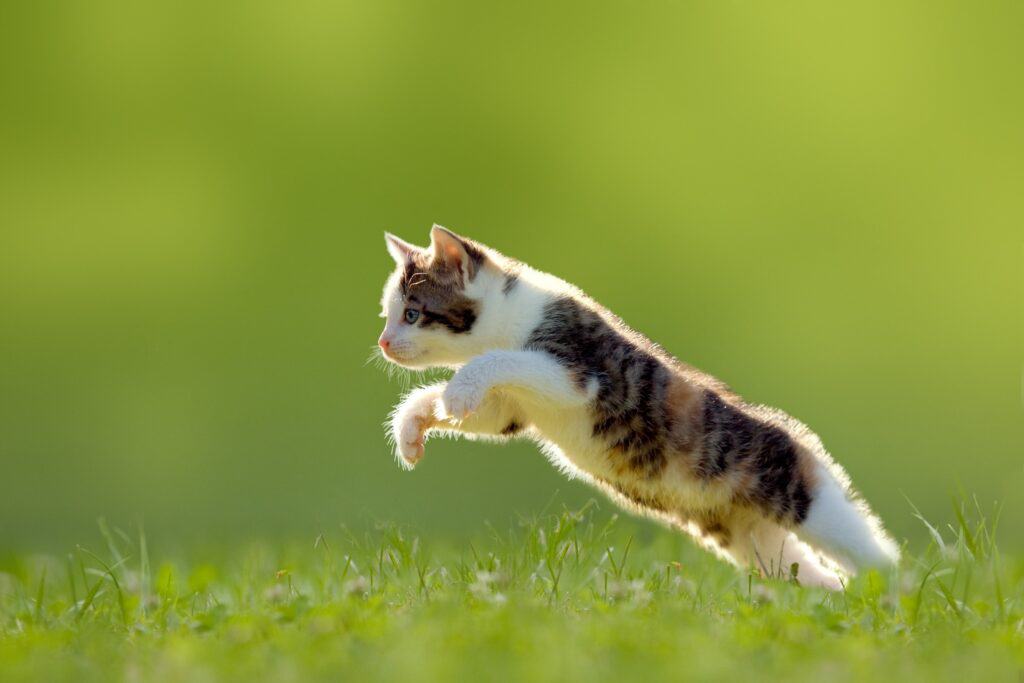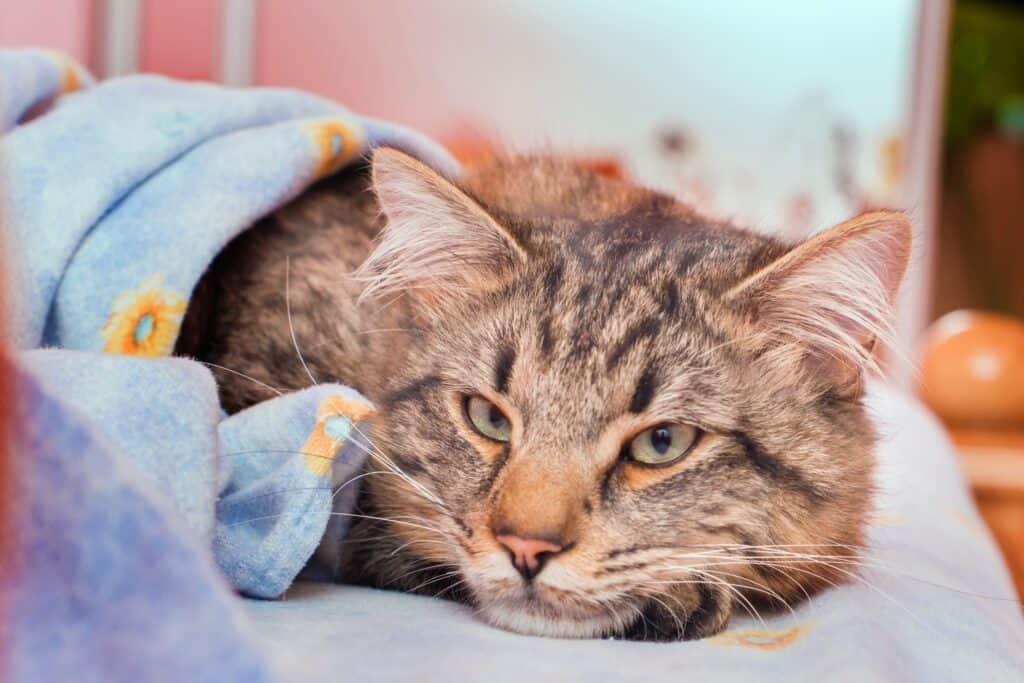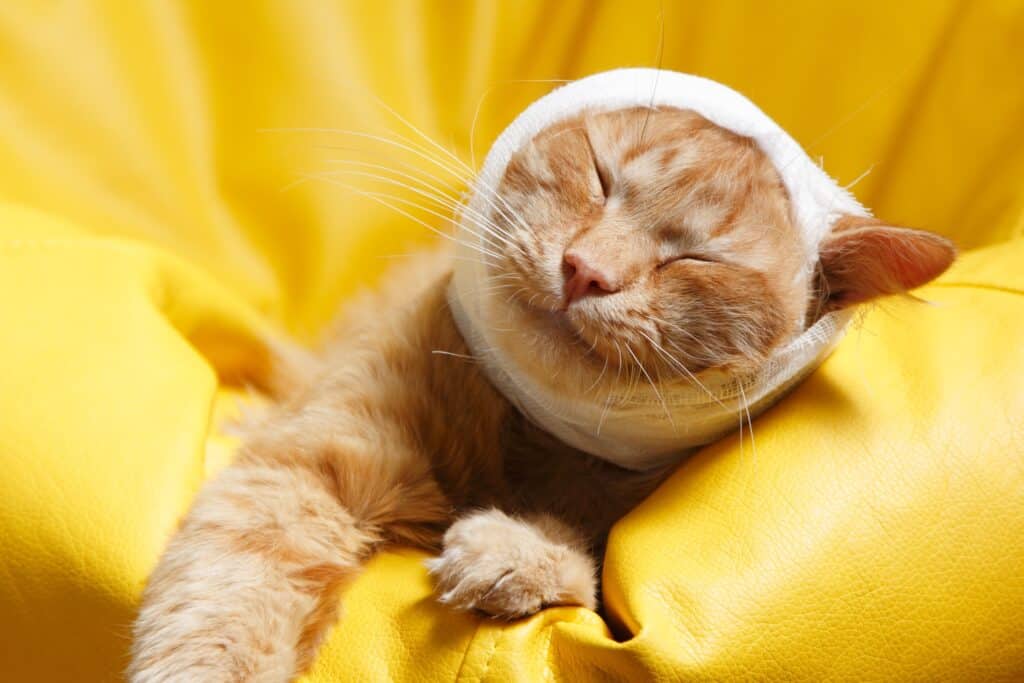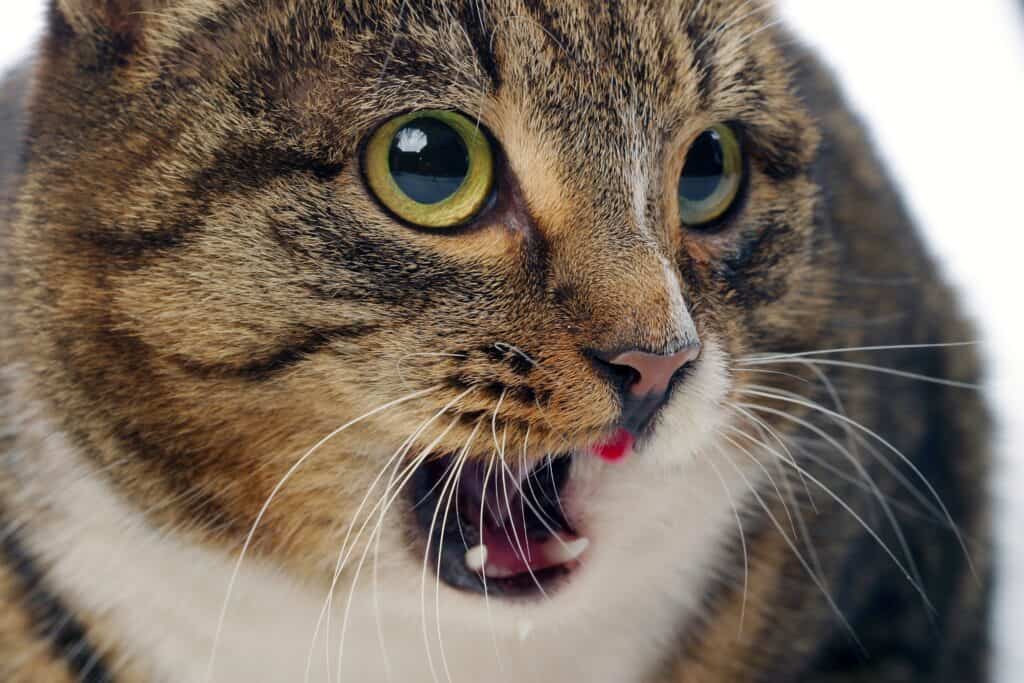Are you wondering why your cat is breathing fast? Before you panic, there are a few reasons why your feline friend may be taking quick breaths.
Rapid breathing is normal during periods of strenuous exercise and play. It can also be caused by stress or being too warm, both things that can usually be easily corrected. But it can also be a symptom of a serious medical condition that needs immediate veterinary attention.
In this article , we’ll go over the most common causes of rapid breathing in cats, when it is normal and when it is a sign of something more serious. If you want an answer to your question of “why is my cat breathing fast”, then read on to learn more about what you should do if you are worried about your cat’s breathing and when to seek medical care.
Why Is My Cat Breathing Fast: Normal Cat Breathing
Understanding what normal cat breathing is will help you recognize when your pet’s breathing is abnormal.
Cat breathing rates and patterns can vary a bit depending on things like age, activity level, and temperature. But in general, a healthy adult cat at rest has a respiratory rate of 16 to 40 breaths per minute. Kittens and very young cats have a slightly higher respiratory rate, and it is slightly lower in older cats.
Normal cat breathing is typically quiet, shallow, and relatively effortless and consistent in its rhythm. Cats should not appear to struggle or strain while breathing when they are at rest.
A cat’s breathing rate can increase naturally for very normal reasons. For example, when cats are active, playing, or exercising, their breathing rates naturally increase to supply more oxygen to their muscles.
Cats may also breathe faster in hot weather or if they are exposed to high temperatures. Although panting is not the primary strategy cats use to cool off, rapid open mouth breathing does help them to dissipate heat.
Kittens and young cats tend to have faster breathing rates than older cats. This is because they have higher metabolic rates and more energy.
Abnormal reasons for fast breathing in cats include illness or stress. Fast breathing that does not go away on its own may be a sign of an underlying medical issue.

Medical Reasons For Breathing Problems In Cats
Rapid breathing, known as tachypnea, can be a physiological response to insufficient oxygen or increased carbon dioxide levels in the bloodstream.
When the body detects a drop in oxygen levels or an increase in carbon dioxide, a rapid breathing response is triggered as a compensatory mechanism to increase oxygen intake or get rid of carbon dioxide.
It can also be a stress response. During a stress response, the “fight or flight” reaction kicks in and the body prepares for action by increasing the body’s oxygen supply which means increasing the respiratory rate.
The list of potential causes of rapid breathing is rather long. We have listed some of them below according to the primary body systems affected.
Lung Disease
Any disease or disorder of the respiratory system that interferes with the body’s ability to expel carbon dioxide and take in sufficient oxygen will lead to rapid breathing.
These conditions include:
- Asthma: A reaction to allergens such as dust, pollen, and fragrances that can cause inflammation and narrowing of the airways, leading to difficulty breathing.
- Pneumonia and bronchitis: Infections, usually viral infections and secondary bacterial infections of the lung causing inflammation and damage within the lungs or airways.
- Pulmonary edema: Fluid accumulation in the lungs due to heart failure or other medical conditions. This thickens air sacs, making it harder for oxygen to move from the lungs into the bloodstream.
- Pleural effusion: A build-up of fluid between the chest wall and the lungs which can put pressure on the lungs and make breathing difficult.
- Collapsed lung: Occurs when air leaks into the space between the lung and chest wall, causing the lung to collapse. This can be caused by a trauma or underlying lung disease.
Heart Disease
Heart disease interferes with the heart’s ability to pump sufficient oxygenated blood to meet the body’s needs. This leads to a lack of sufficient oxygen plus a buildup of carbon dioxide and other waste products that trigger increased respiratory rates.
These conditions include:
- Congestive heart failure: A condition where the heart is unable to pump sufficient blood to meet the body’s needs.
- Hypertrophic cardiomyopathy: A condition that causes the walls of the heart to thicken which increases the size of the heart, makes it difficult for heart to contract, and narrows the heart chambers.
- Dilated cardiomyopathy: A condition where the heart muscle becomes weak and flabby and can’t contract properly.
- Heartworm disease: A parasitic infection that can cause lung damage and heart failure.
- Fluid in the pericardium: The pericardium is a membrane that surrounds the heart. When it fills with excess fluid, it can put pressure on the heart and lungs causing your cat to breathe faster.
Neurologic Disorders
- Head injury or trauma: Injuries to the brain can disrupt the areas of the brain that control breathing. Cats with trauma will also breathe rapidly as a pain and stress response.
- Seizures or epilepsy: Seizures are physically taxing events that can increase a cat’s metabolic rate, leading to an increased need for oxygen.
- Brain tumors: Masses in or on the brain, including gliomas and meningiomas, can impact the region that controls breathing resulting in fast, labored breathing.
Metabolic Disorders
- Diabetes mellitus: Cats in diabetic ketoacidosis will have rapid breathing.
- Hyperthyroidism (overactive thyroid): Rapid breathing in cats with chronic hyperthyroidism is caused by weak respiratory muscles, although central nervous system or psychogenic effects also play a role especially when these cats are stressed.
- Acidosis: Like diabetic ketoacidosis, any type of acidosis causes rapid breathing due to an increase of carbon dioxide in the blood. The rapid breathing is the body’s attempt to expel the excess carbon dioxide.
Other Issues
- Diaphragmatic hernia: A tear in the diaphragm that allows abdominal organs to move into the chest cavity can cause respiratory distress as the lungs have decreased space in which to do their job.
- Anemia: Anemia is a lower than normal level of red blood cells or a decrease in the oxygen-carrying capacity of the blood. There are several different causes including blood loss, impaired red blood cell production, or increased red blood cell destruction.

What To Do If Your Cat Is Breathing Fast
Start by calmly assessing the situation. Is there something that can easily explain your cat’s rapid breathing? For example, is this right after your cat was playing or chasing something?
If the cat has just been exercising vigorously and is panting heavily, it’s probably a normal response to increased physical activity and will disappear when the cat is calm. Simply allow the cat to rest in a cool, quiet, and well-ventilated area, and offer fresh water.
The rapid breathing should gradually subside as the cat recovers. If it doesn’t, or if there are other concerning signs, seek veterinary advice.
If the cat has been startled, chased by a dog, or exposed to a stressful situation, rapid breathing can occur as a stress response. In this case, move the cat to a quiet and secure environment away from the stressor. Give the cat time to calm down, and monitor their breathing. It should return to normal as they relax.
Cats can become overheated in hot weather or when exposed to a hot environment. If heat stress is suspected, move the cat to a cooler area immediately. Ensure adequate ventilation and shade. Offer water, but do not force them to drink. You can also use a damp, cool cloth to gently wipe their fur to help lower their body temperature.
Mild heat stress is easily treatable at home, but if your cat’s breathing doesn’t improve or if they show more severe signs of heat stress such as lethargy or vomiting, seek veterinary care promptly.
When To Take Your Cat To The Vet
If you cannot find a normal, benign reason for your cat’s rapid breathing that can be quickly corrected, then it is time to be concerned.
Rapid or abnormal breathing patterns can indicate a severe and life threatening medical condition that requires immediate veterinary attention.
If you see the following symptoms, take your cat to the vet’s as soon as possible:
- Labored Breathing: If you notice that your cat is visibly struggling to breathe, with pronounced chest movements, flaring nostrils, or exaggerated abdominal effort, it is in respiratory distress and requires immediate medical care.
- Open-Mouth Breathing: Cats normally breathe through their nose when at rest. If your cat is panting or breathing with its mouth open, especially when it’s not overheated or temporarily stressed, it can indicate a severe problem. Seek veterinary care as soon as possible.
- Cyanosis: Any bluish or purplish discoloration of your cat’s lips, gums, or tongue is a sign of a lack of oxygen. This is an emergency situation.
- Gagging or Choking: If your cat appears to be gagging, choking, or retching and is having difficulty breathing, this is an emergency situation.
- Persistent Rapid Breathing: If your cat continues to breathe rapidly for an extended period without an obvious cause like play or exercise, it likely indicates an underlying health issue that needs to be treated by a veterinarian as soon as possible.
- Noisy Breathing: Ongoing wheezing, coughing, or unusual noises during breathing should never be ignored. Seek veterinary care as soon as possible.
- Lethargy and Weakness: Rapid breathing accompanied by lethargy, weakness, or the cat’s inability to stand or move normally can indicate a severe problem. Seek immediate veterinary care.
- Collapse: If your cat collapses or becomes unresponsive while exhibiting rapid breathing, this is a medical emergency.
- Trauma: If your cat has experienced any recent trauma, such as a fall or impact to the head or chest, and is now breathing rapidly, there may be internal injuries that require immediate attention.
- Known Health Conditions: Cats with preexisting heart or respiratory conditions who suddenly start breathing rapidly should be seen by a veterinarian as soon as possible.
- Bleeding: Any signs of external or internal bleeding, along with rapid breathing, is a medical emergency.
- Excessive Salivation: If your cat is drooling excessively and has rapid breathing, it may indicate poisoning or ingestion of a toxic substance. This is a medical emergency.
If you notice any of these clinical signs, contact your veterinarian or an emergency veterinary clinic immediately for instructions. In most cases you will likely be advised to get your cat to a veterinary clinic as soon as possible, since early treatment may save their lives.
Treatment of Breathing Problems in Cats
The treatment of breathing problems in cats depends on the underlying cause and the severity of the issue.
The first step is to identify the underlying cause of the breathing problem. This involves a thorough physical examination by a veterinarian and may include diagnostic tests such as blood tests, X-rays, ultrasound, or other diagnostic tools to get an accurate diagnosis of your pet.
In many cases, oxygen therapy is the first treatment when a cat in respiratory distress arrives at the clinic. This helps the cat to get a steady supply of oxygen while it undergoes examination and diagnostic tests. This can be done through an oxygen mask, oxygen cage, or nasal cannula.
After the cause is narrowed down or identified, some of the treatments given to the cat may include:
- Medications: These could include antibiotics for infections, bronchodilators for asthma or bronchitis, diuretics for heart-related issues, or anti-inflammatory drugs to reduce airway inflammation.
- Fluid Therapy: In cases where dehydration is contributing to the problem, intravenous (IV) or subcutaneous (under the skin) fluids may be given.
- Surgery: In some cases, surgery may be necessary to remove foreign objects from the airway, repair a collapsed lung, or fix a diaphragmatic hernia, among others.
- Fluid drainage: If there is pleural or pericardial effusion, a procedure to drain this fluid may be carried out.
- Hospitalization: Cats with severe breathing problems may require hospitalization for close monitoring and supportive care, especially if they are in critical condition.

Ongoing Home Care
Once the cat is successfully treated and stabilized enough to go home, you will need to follow any instructions provided by their veterinarian for at-home care. This may include:
Home Care: Owners may be instructed on how to administer medications or monitor their cat’s condition at home.
Follow-up Care: After the initial treatment, regular follow-up appointments with the veterinarian may be necessary to monitor the cat’s progress, adjust medications if needed, and for ongoing management of the condition.
Dietary Management: For cats with conditions like obesity, dietary changes may be recommended to reduce weight and ease the respiratory effort.
Environmental Management and Lifestyle Modifications: Cats with asthma and respiratory allergies may benefit from environmental changes, such as eliminating allergens from the home.
Conclusion
Understanding normal breathing patterns in cats is important for identifying when breathing becomes abnormal. While rapid breathing can occur during play, exercise, or in warm conditions, persistent or unusual patterns should not be ignored.
If you notice concerning symptoms, stay calm but act quickly. Assess the situation for immediate benign causes. If none exist or if other symptoms are present, seek veterinary care promptly. Early diagnosis and treatment are essential for managing underlying health issues and improving your pet’s prognosis.
Remember, your vigilance as a pet owner can make a significant difference in detecting and managing respiratory issues in your cat, and may even save their life.
Disclaimer: This article is intended for informational purposes only, and does not constitute medical advice. Always consult your veterinarian if you have specific concerns about your pet’s health.
Sources:
- https://www.merckvetmanual.com/multimedia/table/resting-respiratory-rates
- https://www.ncbi.nlm.nih.gov/books/NBK482456/
- https://www.merckvetmanual.com/cat-owners/lung-and-airway-disorders-of-cats/introduction-to-lung-and-airway-disorders-of-cats
- https://www.lung.org/lung-health-diseases/how-lungs-work
- https://www.merckvetmanual.com/cat-owners/heart-and-blood-vessel-disorders-of-cats/heart-disease-and-heart-failure-in-cats
- https://cat-bytes.com/my-cat-is-wheezing/
- https://cat-bytes.com/my-cat-is-breathing-heavy/
- https://cat-bytes.com/is-my-cat-sick-signs-to-look-for/
- https://cat-bytes.com/why-is-my-cat-sneezing/

